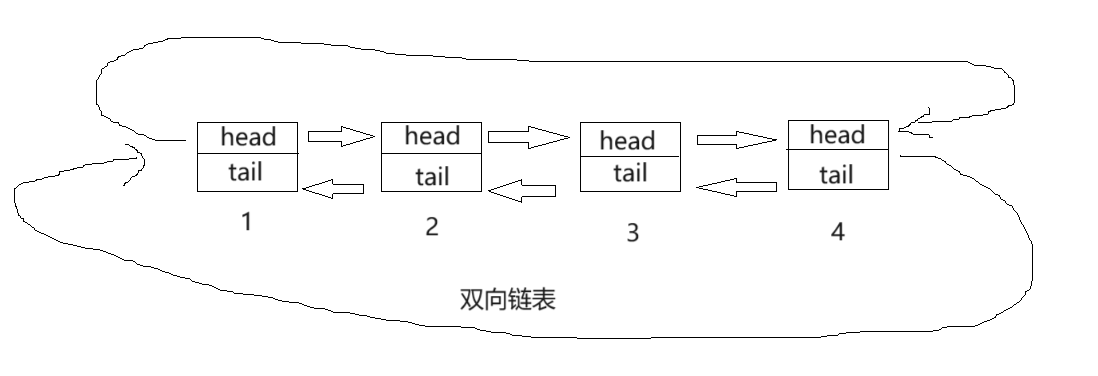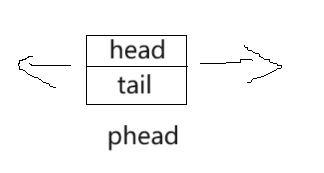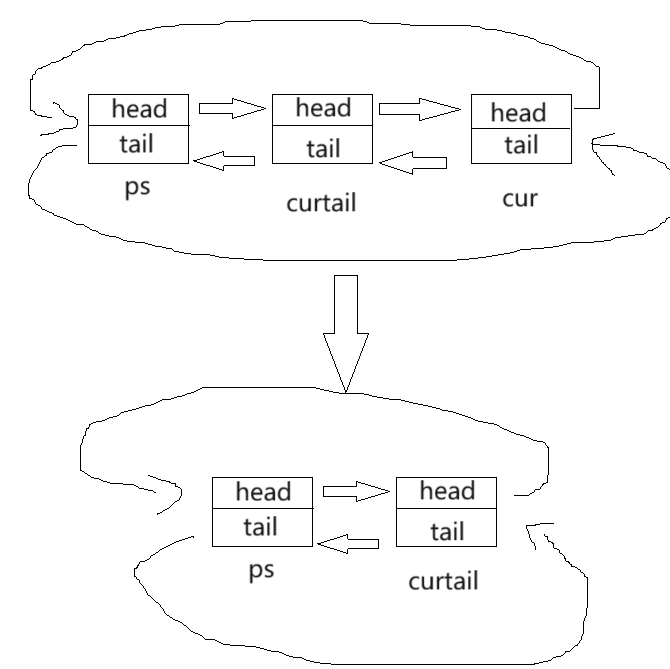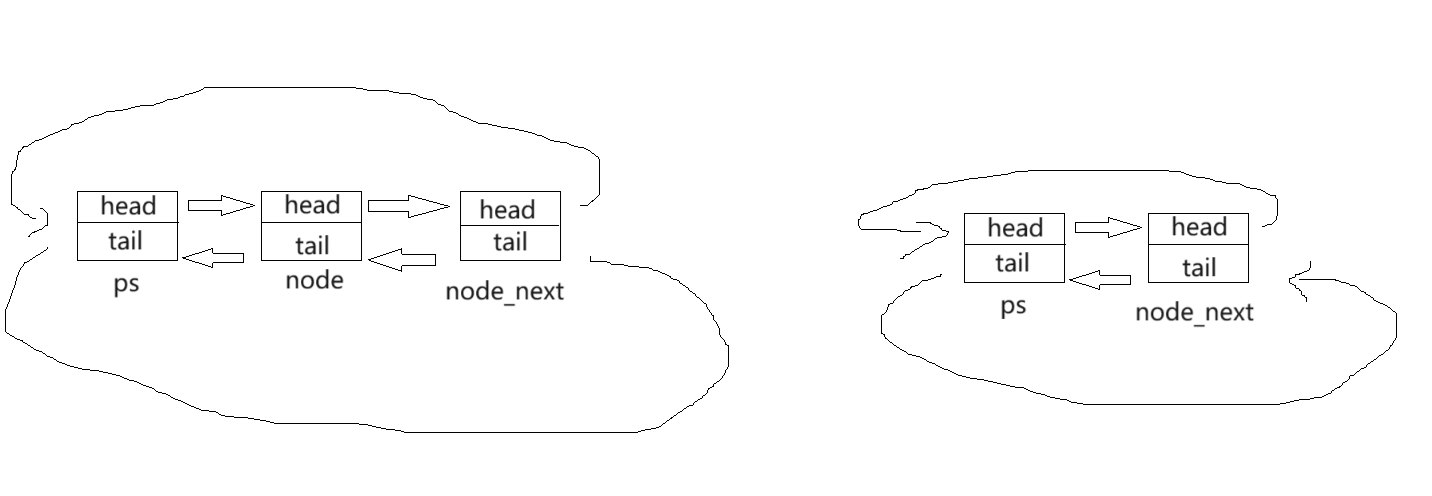
????????????????
????????????????
🌿🌿🌿🌿🌿🌿🌿🌿🌿🌿🌿🌿🌿🌿🌿🌿
🌟🌟🌟🌟🌟🌟🌟🌟🌟🌟🌟🌟🌟🌟🌟🌟
🌟🌟 追風趕月莫停留 🌟🌟
🍀🍀🍀🍀🍀🍀🍀🍀🍀🍀🍀🍀🍀🍀🍀🍀
🌟🌟 平蕪盡處是春山🌟🌟
🌟🌟🌟🌟🌟🌟🌟🌟🌟🌟🌟🌟🌟🌟🌟🌟
🌿🌿🌿🌿🌿🌿🌿🌿🌿🌿🌿🌿🌿🌿🌿🌿
????????????????
????????????????
🍋雙向鏈表
- 🍌雙向鏈表的定義與結構
- 🍌雙向鏈表增刪查改(有頭+雙向+循環鏈表增刪查改實現)
- 🍍其它接口
- 🍍創建返回鏈表的頭結點
- 🍍雙向鏈表銷毀
- 🍍雙向鏈表打印
- 🍍雙向鏈表尾插
- 🍍雙向鏈表尾刪
- 🍍雙向鏈表頭插
- 🍍雙向鏈表頭刪
- 🍍雙向鏈表查找
- 🍍雙向鏈表在pos的前面進行插入
- 🍍雙向鏈表刪除pos位置的節點
- 🍌雙向鏈表整體代碼的實現
🍌雙向鏈表的定義與結構

雙向鏈表:雙向鏈表也叫雙鏈表,是鏈表的一種,它的每個數據結點中都有兩個指針,分別指向直接后繼和直接前驅。所以,從雙向鏈表中的任意一個結點開始,都可以很方便地訪問它的前驅結點和后繼結點。一般我們都構造雙向循環鏈表。(兩個指針就是一個指向下一個數據,另一個指針指向上一個數據。如圖中head頭指針和tail尾指針)

在雙向鏈表中還有一個特殊點,就是頭指針,雙向鏈表是帶頭的。在上次我們說的單鏈表中是不帶頭的,一旦涉及到頭,我們就是先判斷是不是為空,而在雙向鏈表中就是不會涉及到這個問題了,不用再去一個一個的判斷,就會省去很多的麻煩。
帶頭的雙向鏈表嘴尾常用,所以我們這里就介紹帶頭的雙向鏈表
🍌雙向鏈表增刪查改(有頭+雙向+循環鏈表增刪查改實現)
🍍其它接口
#include<stdio.h>
#include<assert.h>
#include<stdlib.h>typedef int LTdatetype;typedef struct ListNode
{LTdatetype date;struct ListNode* next;struct ListNode* tail;
}ListNode;
定義一些接口
🍍創建返回鏈表的頭結點
//創建返回鏈表的頭結點
ListNode* Create(LTdatetype x)
{ListNode* cur =(ListNode*)malloc(sizeof(ListNode));if (cur == NULL){perror("malloc faild");exit(-1);}cur->next = NULL;cur->tail = NULL;cur->date = x;return cur;
}ListNode* Inia()
{ListNode* node = Create(0);node->next = node;node->tail = node;return node;
}Create函數就是創建一個節點。而Inia函數本來是進行初始化,而想要變成循環的鏈表,形參改變實參那就要用到二級指針,因為這里是雙向鏈表,涉及頭指針的時候不需要考慮二級指針,所以在這里就只有初始化需要用到頭指針,所以我們就干脆用返回值,這樣就不看起來違和了,當然用二級指針也沒有什么問題,看自己習慣即可。
🍍雙向鏈表銷毀
// 雙向鏈表銷毀
void Destreoy(ListNode* ps)
{assert(ps);ListNode* cur = ps->next;while (cur != ps){cur = cur->next;free(cur->tail);}free(ps);
}🍍雙向鏈表打印
// 雙向鏈表打印
void Print(ListNode* ps)
{assert(ps);ListNode* cur = ps->next;while (cur != ps){printf("%d<=>", cur->date);cur = cur->next;}
}

在這里打印,我們就不能使用和單鏈表打印的方法了,因為我們這里是循環鏈表,并且我們的ps里面沒有存有數據,所以我們要從ps的下個數據開始,也就是圖中cur的位置,然后在cur到ps的時候跳出循環就可以了。
🍍雙向鏈表尾插
// 雙向鏈表尾插
void LTpushbake(ListNode* ps, LTdatetype x)
{assert(ps);ListNode* cur = Create(x);ListNode *node = ps->tail ;//ps的頭要指向curnode->next = cur;//cur的尾要指向pscur->tail = node;//ps的尾要指向curps->tail = cur;//cur的頭要指向pscur->next = ps;
}

之所以要這樣的指向,是因為這是一個循環的雙向鏈表。
🍍雙向鏈表尾刪
// 雙向鏈表尾刪
void LTpopbake(ListNode* ps)
{assert(ps);assert(ps->next != ps);ListNode* cur = ps->tail;ListNode* curtail = cur->tail;free(cur);cur->next = cur->tail = NULL;curtail->next = ps;ps->tail = curtail;}

在這里因為這是循環鏈表所以不用遍歷去找尾結點,當然用遍歷也是可以的
🍍雙向鏈表頭插
// 雙向鏈表頭插
void LTpushfront(ListNode* ps, LTdatetype x)
{assert(ps);ListNode* node = Create(x);ListNode* cur = ps->next;ps->next = node;node->tail = ps;node->next = cur;cur->tail = node;}

在帶頭的鏈表中,頭插是最方便的,不用像不帶頭的單鏈表中一個一個去判斷,大大的節省了我們的時間
🍍雙向鏈表頭刪
// 雙向鏈表頭刪
void LTpopfront(ListNode* ps)
{assert(ps);assert(ps->next != ps);ListNode* node = ps->next;ListNode* node_next = node->next;free(node);ps->next = node_next;node_next->tail = ps;
}

在帶頭的鏈表中,頭刪也很方便了。
🍍雙向鏈表查找
// 雙向鏈表查找
ListNode * LTfind(ListNode* ps, LTdatetype x)
{assert(ps);ListNode* cur = ps->next;while (cur != ps){if (cur->date == x){return cur;}cur = cur->next;}return NULL;
}
關于這個查找還是要注意下,因為我們這里是循環鏈表,所以要注意記得要設置跳出循環的條件。
🍍雙向鏈表在pos的前面進行插入
// 雙向鏈表在pos的前面進行插入
void LTinsert(ListNode *pos, LTdatetype x)
{assert(pos);ListNode* node = Create(x);ListNode* pos_tail = pos->tail;pos_tail->next = node;node->tail = pos_tail;node->next = pos;pos->tail = node;}
在pos前插入和頭插,尾插差不多的意思
🍍雙向鏈表刪除pos位置的節點
// 雙向鏈表刪除pos位置的節點
void LTdelete(ListNode* pos)
{assert(pos);ListNode* pos_tail = pos->tail;ListNode* pos_next = pos->next;free(pos);pos_tail->next = pos_next;pos_next->tail = pos_tail;
}

刪除pos位置,也差不多和前面意思都差不多
🍌雙向鏈表整體代碼的實現
#include<stdio.h>
#include<assert.h>
#include<stdlib.h>typedef int LTdatetype;//創建返回鏈表的頭結點
typedef struct ListNode
{LTdatetype date;struct ListNode* next;struct ListNode* tail;
}ListNode;ListNode* Create(LTdatetype x)
{ListNode* cur = (ListNode*)malloc(sizeof(ListNode));if (cur == NULL){perror("malloc faild");exit(-1);}cur->next = NULL;cur->tail = NULL;cur->date = x;return cur;
}ListNode* Inia()
{ListNode* node = Create(0);node->next = node;node->tail = node;return node;
}// 雙向鏈表銷毀
void Destreoy(ListNode* ps)
{assert(ps);ListNode* cur = ps->next;while (cur != ps){cur = cur->next;free(cur->tail);}free(ps);
}// 雙向鏈表打印
void LTprint(ListNode* ps)
{assert(ps);ListNode* cur = ps->next;printf("ps<=>");while (cur != ps){printf("%d<=>", cur->date);cur = cur->next;}printf("\n");
}// 雙向鏈表尾插
void LTpushbake(ListNode* ps, LTdatetype x)
{assert(ps);ListNode* cur = Create(x);ListNode* node = ps->tail;node->next = cur;cur->tail = node;ps->tail = cur;cur->next = ps;
}// 雙向鏈表尾刪
void LTpopbake(ListNode* ps)
{assert(ps);assert(ps->next != ps);ListNode* cur = ps->tail;ListNode* curtail = cur->tail;free(cur);curtail->next = ps;ps->tail = curtail;}// 雙向鏈表頭插
void LTpushfront(ListNode* ps, LTdatetype x)
{assert(ps);ListNode* node = Create(x);ListNode* cur = ps->next;ps->next = node;node->tail = ps;node->next = cur;cur->tail = node;}// 雙向鏈表頭刪
void LTpopfront(ListNode* ps)
{assert(ps);assert(ps->next != ps);ListNode* node = ps->next;ListNode* node_next = node->next;free(node);ps->next = node_next;node_next->tail = ps;
}// 雙向鏈表查找
ListNode * LTfind(ListNode* ps, LTdatetype x)
{assert(ps);ListNode* cur = ps->next;while (cur != ps){if (cur->date == x){return cur;}cur = cur->next;}return NULL;
}// 雙向鏈表在pos的前面進行插入
void LTinsert(ListNode *pos, LTdatetype x)
{assert(pos);ListNode* node = Create(x);ListNode* pos_tail = pos->tail;pos_tail->next = node;node->tail = pos_tail;node->next = pos;pos->tail = node;}// 雙向鏈表刪除pos位置的節點
void LTdelete(ListNode* pos)
{assert(pos);ListNode* pos_tail = pos->tail;ListNode* pos_next = pos->next;free(pos);pos_tail->next = pos_next;pos_next->tail = pos_tail;
}void test1()//測試
{ListNode* ps = Inia();LTpushbake(ps, 1);//尾插LTpushbake(ps, 2);//尾插LTpushbake(ps, 3);//尾插LTpushbake(ps, 4);//尾插LTprint(ps);//打印LTpopbake(ps);//尾刪LTprint(ps);//打印LTpushfront(ps, 10);//頭插LTpushfront(ps, 11);//頭插LTpushfront(ps, 12);//頭插LTpushfront(ps, 13);//頭插LTprint(ps);//打印LTpopfront(ps);//頭刪LTprint(ps);//打印ListNode *pos = LTfind(ps, 11);//雙向鏈表查找if (pos == NULL){printf("沒找到\n");}else{printf("找到了,為:%d\n", pos->date);}LTinsert(pos, 100);// 雙向鏈表在pos的前面進行插入LTprint(ps);//打印LTdelete(pos);//雙向鏈表刪除pos位置的節點LTprint(ps);//打印Destreoy(ps);//雙向鏈表銷毀
}int main()
{test1();//測試return 0;
}帶頭的雙向鏈表實現起來還是非常簡單的,大家如果對于文章中的某一個點有問題,歡迎私聊我。





)




的需求規范)

)







